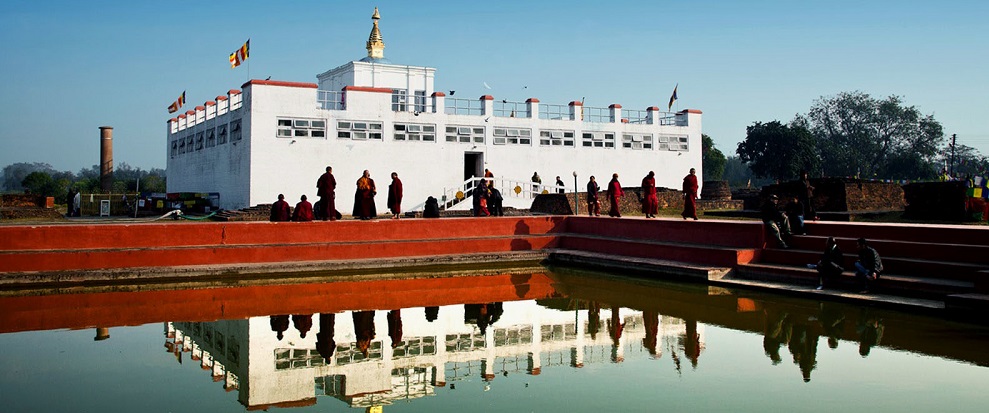Buddha tourism in India stands as a compelling and spiritually enriching experience, drawing pilgrims, scholars, and tourists from across the globe. The country, often referred to as the birthplace of Buddhism, is dotted with sacred sites associated with the life and teachings of Siddhartha Gautama, who later became known as the Buddha. The allure of Buddha tourism in India lies in its ability to offer a profound journey through the life and philosophy of one of the world's greatest spiritual leaders.
Lumbini - The Birthplace of Buddha:
At the heart of Buddha tourism in India is Lumbini, located in present-day Nepal but closely tied to India's cultural and spiritual history. Lumbini is revered as the birthplace of Siddhartha Gautama, and the Maya Devi Temple marks the spot where he was born. Pilgrims and tourists alike visit this sacred site to witness the historical significance and experience the tranquil atmosphere that surrounds the gardens and ponds of Lumbini.
Bodh Gaya - Enlightenment under the Bodhi Tree:
Bodh Gaya, situated in the Indian state of Bihar, is where Siddhartha Gautama attained enlightenment under the Bodhi Tree. The Mahabodhi Temple Complex, a UNESCO World Heritage Site, stands as a testament to the transformative moment in Buddha's life. Pilgrims meditate under the Bodhi Tree, and the temple complex houses the Vajrasana or the Diamond Throne, believed to be the exact spot where Buddha achieved enlightenment.
Sarnath - First Sermon and the Dhamek Stupa:
Sarnath, near Varanasi, holds great significance in Buddha tourism as it is where Buddha delivered his first sermon, known as the Dhammacakkappavattana Sutta. The Dhamek Stupa, a massive structure built to commemorate this event, stands as a majestic symbol of Buddhism. Pilgrims and tourists visit Sarnath to explore the archaeological ruins, the Mulagandha Kuti Vihara, and the Ashoka Pillar, all contributing to the spiritual ambiance of the site.
Kushinagar - The Final Resting Place:
Kushinagar, where Buddha attained Mahaparinirvana or left his mortal coil, is another crucial stop in Buddha tourism. The Ramabhar Stupa and the Nirvana Temple are key attractions, drawing visitors to pay homage to the place where Buddha reached the state of final liberation. The serene surroundings of Kushinagar add a contemplative aspect to the pilgrimage, making it a destination of deep spiritual significance.
Dharamshala and McLeod Ganj - Tibetan Buddhism in India:
Beyond the traditional sites associated with Siddhartha Gautama, India is also home to Tibetan Buddhism. Dharamshala, especially McLeod Ganj, serves as the seat of the Tibetan government-in-exile and the residence of the 14th Dalai Lama. Here, visitors can immerse themselves in the teachings of Tibetan Buddhism, explore monasteries, and witness the vibrant Tibetan culture. The Tsuglagkhang Complex, including the Namgyal Monastery, is a focal point for spiritual seekers.
Ajanta and Ellora Caves - Buddhist Art and Architecture:
The Ajanta and Ellora Caves in Maharashtra showcase the rich artistic and architectural heritage of Buddhism. These UNESCO World Heritage Sites feature intricately carved cave temples that depict Buddha's life through vivid sculptures and paintings. The caves serve as a testament to the flourishing of Buddhist art and philosophy in ancient India.
Diverse Cultural Experiences:
Buddha tourism in India offers a diverse range of cultural experiences. From participating in meditation retreats to attending teachings by Buddhist monks, visitors can engage with the living traditions of Buddhism. Festivals like Buddha Purnima, celebrating the birth, enlightenment, and death of Buddha, provide an immersive cultural experience with processions, prayers, and celebrations.
Spiritual Retreats and Meditation Centers:
India is home to numerous meditation centers and retreats that cater to those seeking a deeper understanding of Buddhist meditation techniques. These centers, often situated in serene natural surroundings, offer immersive experiences for individuals looking to embark on a spiritual journey or simply find moments of peace and introspection.
Culinary Delights and Local Hospitality:
Exploring Buddha Tourism in India is not just about spiritual encounters; it also involves experiencing the local culture, including cuisine and hospitality. Many of the regions associated with Buddhism offer a variety of vegetarian dishes influenced by the monastic traditions. Visitors can savor the flavors of local cuisine and enjoy the warm hospitality of the communities surrounding these sacred sites.
In conclusion,
Buddha tourism in India stands out as a top destination due to the profound spiritual experiences it offers, the historical significance of the sacred sites, and the rich cultural tapestry that surrounds the life and teachings of Siddhartha Gautama. From the birthplace in Lumbini to the enlightenment in Bodh Gaya, and the final resting place in Kushinagar, each site contributes to a transformative journey that transcends time and connects visitors to the essence of Buddhism. Beyond the historical landmarks, India's diverse landscapes, cultural experiences, and the living traditions of Buddhism make it a destination that resonates with seekers of both spiritual and cultural enrichment.

